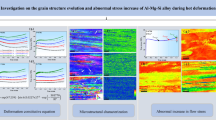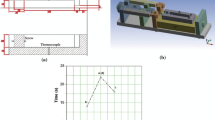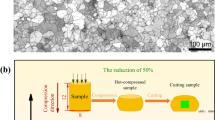Abstract
Results of finite element method (FEM) thermal stress analyses during solidification of an Al–Mg alloy with different grain sizes revealed the contribution of the macroscopic strain to the reduction of hot tearing susceptibility by the grain refinement. This study used an elasto-creep model to describe the mechanical behavior of the alloy in the semi-solid state. The grain size–dependence was described using the experimentally determined two parameters of n (=dlog\( {\dot{\upvarepsilon}}^{\mathrm{c}} \)/dlogσ) and A in the power-law creep model in earlier work. Results showed that grain refinement makes the creep strain distribution more uniform and suppresses the maximum strain value during solidification, which in turn should contribute to reducing the hot tearing susceptibility. This result demonstrates that the grain size–dependence of the two creep parameters during the solidification is a key factor for the quantitative prediction of hot tearing tendency with the consideration of grain size.
Similar content being viewed by others
References
Lees DCG (1946) The hot-tearing tendencies of aluminum casting alloys. J Inst Met 72:343–364
Lin S, Aliravci C, Pekguleryuz MO (2007) Hot-tear susceptibility of aluminum wrought alloys and the effect of grain refining. Metall Mater Trans A 38:1056–1068
Kimura R, Hatayama H, Shinozaki K, Murashima I, Asada J, Yoshida M (2009) Effect of grain refiner and grain size on the susceptibility of Al–Mg die casting alloy to cracking during solidification. J Mater Process Technol 209:210–219
Grandfield JF, Eskin DG, Bainbridge IF (2013) Direct-chill casting of light alloys. Wiley-TMS, pp:103–143
Pellini W (1952) Strain theory of hot tearing. Foundry 80:125–137
Bishop HF, Ackerlind CG, Pellini WS (1957) Investigation of metallurgical and mechanical effects in the development of hot tearing. Trans Am Foundry Soc 65:247–258
Campbell J (1992) Castings second edition. Butterworth-Heinemann, pp 242–258
Eskin DG, Suyitno, Katgerman K (2004) Mechanical properties in the semi-solid state and hot tearing of aluminium alloys. Prog Mater Sci 49:629–711
Magnin B, Maenner L, Katgerman L, Engler S (1996) Ductility and rheology of an Al–4.5%Cu alloy from room temperature to coherency temperature. Mater Sci Forum 222:1209–1214
Nagaumi H, Umeda T (2002) Prediction of internal cracking in a direct-chill cast, high strength, Al–Mg–Si alloy. J Light Met 2:161–167
M'Hamdi M, Benum S, Mortensen D, Fjær HG, Drezet J-M (2003) The importance of viscoplastic strain rate in the formation of center cracks during the start-up phase of direct-chill cast aluminum extrusion ingots. Metall Mater Trans A 34:1941–1952
Suyitno KWH, Katgerman L (2004) Finite element method simulation of mushy zone behavior during direct-chill casting of an Al–4.5 pct Cu alloy. Metall Mater Trans A 35:2918–2926
Pokorny M, Monroe C, Beckermann C, Bichler L, Ravindran C (2008) Prediction of hot tear formation in a magnesium alloy permanent mold casting. Int J Met 2:41–53
Shi Z, Dong J, Zhang M, Zheng L (2014) Hot tearing susceptibility analysis and prediction of K418 superalloy for auto turbocharger turbine wheel. Trans Nonferrous Metals Soc China 24:2737–2751
Prokhorov NN (1962) Resistance to hot tearing of cast metals during solidification Russian Casting Production 2:172–175
Phillion AB, Cockcroft SL, Lee PD (2009) Predicting the constitutive behavior of semi-solids via a direct finite element simulation: application to AA5182. Model Simul Mater Sci Eng 17:055011
Jamaly N, Phillion AB, Drezet J-M (2013) Stress–strain predictions of semisolid Al–Mg–Mn alloys during direct chill casting: effects of microstructure and process variables. Metall Mater Trans B Process Metall Mater Process Sci 44:1287–1295
Phillion AB, Cockcroft SL, Lee PD (2008) A three-phase simulation of the effect of microstructural features on semi-solid tensile deformation. Acta Mater 56:4328–4338
Takai R, Matsushita A, Yanagida S, Nakamura K, Yoshida M (2015) Development of an elasto-viscoplastic constitutive equation for an Al–Mg alloy undergoing a tensile test during partial solidification. Mater Trans 56:1233–1241
Takai R, Kimura S, Kashiuchi R, Kotaki H, Yoshida M (2016) Grain refinement effects on the strain rate sensitivity and grain boundary sliding in partially solidified Al–5 wt.%Mg alloy. Mater Sci Eng A 667:417–425
Takai R, Tsunoda T, Kawada Y, Hirohara R, Okane T, Yoshida M (2018) Effect of temperature field and mechanical properties of casting on prediction of hot tearing tendency using FEM thermal stress analysis. Mater Trans 59:1333–1340
Stangeland A, Mo A, M'Hamdi M, Viano D, Davidson C (2006) Thermal strain in the mushy zone related to hot tearing. Metall Mater Trans A 37:705–714
Pokorny MG, Monroe CA, Beckermann C, Zhen Z, Hort N (2010) Simulation of stresses during casting of binary Mg-Al alloys. Metall Mater Trans A 41:3196–3207
Giraud E, Suery M, Coret M (2010) Mechanical behavior of AA6061 aluminum in the semisolid state obtained by partial melting and partial solidification. Metall Mater Trans A 41:2257–2268
Hirohara R, Kawada K, Takai R, Otaki M, Okane T, Yoshida M (2017) Prediction and experimental validation of cooling rate dependence of viscoplastic properties in a partially solidified state of Al–5mass%Mg alloy. Mater Trans 58:1299–1307
Singer ARE, Cottrell SA (1947) Properties of the aluminum–silicon alloys at temperatures in the region of the solidus. J Inst Met 73:33–54
Dahle AK, Arnberg L (1997) Development of strength in solidifying aluminium alloys. Acta Mater 45:547–559
Metz SA, Flemings MC (1970) A fundamental study of hot tearing. AFS Trans 78:453–460
Kubota M, Kitaoka S (1973) Solidification behavior and hot tearing tendency of aluminum casting alloys. AFS Trans 81:424–427
Alankar A, Wells MA (2010) Constitutive behavior of as-cast aluminum alloys AA3104, AA5182 and AA6111 at below solidus temperatures. Mater Sci Eng A 527:7812–7820
Odqvist FKG (1974) Mathematical theory of creep and creep rupture second edition. Clarendon Press, pp. 22
Norton FH (1929) The creep of steel at high temperatures. McGraw-Hill Book Company, pp. 67
Bailey RW (1935) The utilization of creep test data in engineering design. Proc Inst Mech eng 131:131–349
Eskin DG, Suyitno MJF, Katgerman L (2004) Contraction of aluminum alloys during and after solidification. Metall Mater Trans A 35:1325–1335
Stangeland A, Mo A, Nielsen Ø, Eskin D, M'Hamdi M (2004) Development of thermal strain in the coherent mushy zone during solidification of aluminum alloys. Metall Mater Trans A 35:2903–2915
Drezet J-M, Eggeler G (1994) High apparent creep activation energies in mushy zone microstructures. Scripta Metall Mater 31:757–762
Hao H, Maijer DM, Wells MA, Phillion A, Cockcroft SL (2010) Modeling the stress-strain behavior and hot tearing during direct chill casting of an AZ31 magnesium billet. Metall Mater Trans A 41:2067–2077
D'Elia F, Ravindran C, Sediako D (2015) Interplay among solidification, microstructure, residual strain and hot tearing in B206 aluminum alloy. Mater Sci Eng A 624:169–180
Prasad YVRK, Seshacharyulu T (1998) Modelling of hot deformation for microstructural control. Inter Mater Rev 43:243–258
Narayana Murty SVS, Nageswara Rao B, Kashyap BP (2000) Instability criteria for hot deformation of materials. Inter Mater Rev 45:15–26
Sheikh Ansari MH, Aghaie-Khafri M (2018) Predicting flow localization in semi-solid deformation. Inter J Mater Form 11:165–173
Author information
Authors and Affiliations
Corresponding author
Rights and permissions
About this article
Cite this article
Takai, R., Endo, N., Hirohara, R. et al. Experimental and numerical analysis of grain refinement effect on hot tearing susceptibility for Al–Mg alloys. Int J Adv Manuf Technol 100, 1867–1880 (2019). https://doi.org/10.1007/s00170-018-2791-2
Received:
Accepted:
Published:
Issue Date:
DOI: https://doi.org/10.1007/s00170-018-2791-2




